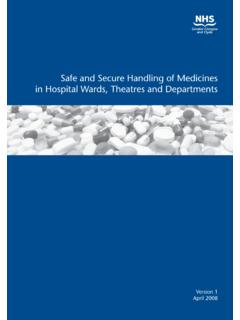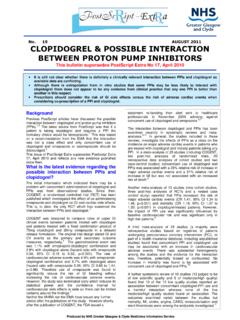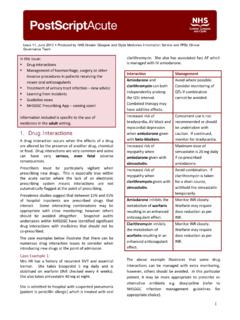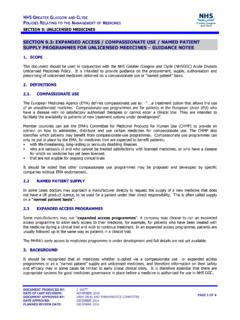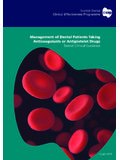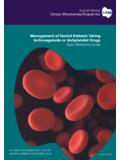Transcription of NOAC Prescribing in Patients with Non-Valvular …
1 NOAC Prescribing in Patients with Non-Valvular Atrial Fibrillation: Frequently Asked Questions FAQ document jointly prepared by NHSGGC Haematology Service & Medicines Information On behalf of the Heart MCN (February 2015) This document supersedes previous document entitled Guidance on anticoagulant Choice in Patients with Non-Valvular Atrial Fibrillation, Version 2 August 2014 NOAC Prescribing in Patients with Non-Valvular Atrial Fibrillation Contents Page 2 Section 1: Questions relating to indications/appropriateness of NOACs Patients with prosthetic heart Page 2 Patients with a heart Page 2 Section 2: Questions relating to choice of NOAC & dose Choosing the most appropriate agent and Page 2 Patients with renal Page 3 Do I need to recalculate creatinine clearance every year?.. Page 4 Elderly Patients with low body Page 4 Interactions with Page 4 NOACS and Page 4 Drug/food .. Page 5 Nasogastric Page 5 Use in compliance Page 5 Section 3: Questions relating to NOAC initiation Initiation procedure in newly diagnosed Page 5 Switching from Page 5 Switching from warfarin if INR is Page 5 Section 4: Further information and advice Patient education Page 6 Patient alert Page 6 Who should educate the patient?
2 Page 6 Monitoring Page 6 Useful contacts for further Page 6 Algorithm 1: NOAC choices in AF Patients without renal impairment Algorithm 2: NOAC choices in AF Patients with creatinine clearance 30-49ml/min Algorithm 3: NOAC choices in AF Patients with creatinine clearance 15 29ml/min Appendix 1: Additional information 1 NOAC Prescribing in Patients with Non-Valvular Atrial Fibrillation Introduction NHSGGC guidance states that Patients with Non-Valvular atrial fibrillation (AF), who are believed to be adhering to warfarin therapy but have a poorly controlled INR, should be considered for a Novel Oral anticoagulant (NOAC). A poorly controlled INR in this context is defined as therapeutic INR < 60% of the time. The NOACs (apixaban, dabigatran and rivaroxaban) should result in more stable anticoagulation. The Glasgow and Clyde Anticoagulation Service (GCAS) will identify such Patients and contact their GPs to suggest consideration of a switch to one of the NOACs.
3 Various factors may influence the decision to change to a NOAC and the choice between the three agents. GPs should consider these factors and patient preference before making a final decision. The 2014 NHSGGC AF guideline also includes an option to prescribe a NOAC as a first-line anticoagulant in Patients newly diagnosed with Non-Valvular AF requiring anticoagulation. Section 1: Questions relating to indications/appropriateness of NOACs My patient has AF and a prosthetic heart valve - is he eligible for a NOAC? No - NOACs are not indicated in Patients with rheumatic mitral stenosis, mechanical prosthetic heart valve or who have had a valve repair or a tissue valve replacement. Given that NOACS are not indicated in Patients with valvular disease - if a patient has a heart murmur and new AF should I initiate a NOAC or wait until the cause of the murmur is established? A NOAC should be initiated immediately rather than delaying anticoagulation in a patient with AF.
4 If valvular heart disease is later diagnosed (for example from an echocardiogram) the patient should be referred to cardiology who will review medicines as appropriate. Section 2: Questions relating to choice of NOAC & dose All 3 NOACs are indicated for AF and the dosing regimens are all different. How do I choose the most appropriate agent and dose for my patient? The NOACs all have slightly different properties and the best choice of agent and dose may be dependent on individual patient characteristics. Factors such as indication for treatment, renal function, age, body weight, ability to swallow medicines and the need for a compliance aid may be relevant. All three NOACs are on the GGC Formulary for switching from warfarin due to poor INR control. Apixaban and dabigatran but not rivaroxaban are on the Formulary for newly diagnosed AF. For Patients without renal impairment (creatinine clearance [CrCl] > 50ml/min) any of the three NOACs may be used and the other factors described above will be more important in determining choice of agent and appropriate dose.
5 Algorithm 1 takes these factors into consideration and helps define the available options and doses for individual Patients In Patients where there are no specific factors affecting agent or dose, the choice depends simply on licensed indications and personal preference. Prescribers may find it helpful to become familiar with one NOAC in particular. 2 NOAC Prescribing in Patients with Non-Valvular Atrial Fibrillation Is there a preferred choice of NOAC in a patient with renal impairment and is a dose reduction necessary? All 3 NOACs may be used but the agent and dose depends on the degree of impairment: Creatinine Clearance 30 49ml/min All 3 NOACs may be used in this degree of renal impairment. Depending on other factors dose reductions may be required - use Algorithm 2 Creatinine Clearance 15 29ml/min Dabigatran is contraindicated. Apixaban or rivaroxaban may be used but require dose reductions - use Algorithm 3 Creatinine Clearance <15ml/min All NOACs are contraindicated if CrCl is less than 15ml/min Do not use eGFR to evaluate degree of renal impairment.
6 The Cockcroft Gault equation can be used to estimate CrCl: There is also an online Cockroft Gault calculator which may be found here. (Please note that if you are accessing from an NHS computer you will be taken directly to the calculator, though you may have to scroll down to see it. If you are accessing from outwith the NHS you will need to login first using an NHSS cotland Athens password). Warning: for Patients with an age greater than 70 years or with an ideal weight outside of the range 45 90kg the online calculator may issue a warning about validity of the result but will still generate an estimated CrCl. As described above Cockroft Gault is used to estimate creatinine clearance and has some limitations. In Patients where the creatinine clearance is borderline for dose reduction/contraindication it may be particularly important to consider other risk factors (see decision making algorithms) when choosing the most appropriate dose.
7 Regardless of whether this calculation is done manually or using the calculator the following should be considered: Use 60 micromol/L if the creatinine concentration is < 60 micromol/L This equation may overestimate CrCl in elderly or malnourished Patients Use ideal body weight (see below) rather than actual body weight Ideal body weight (IBW) estimation Height Feet/inches Height cm Female IBW Male IBW 5 152 50 5 1 155 5 2 157 5 3 160 5 4 163 5 5 165 57 5 6 168
8 5 7 170 5 8 173 5 9 175 5 10 178 73 5 11 180 6 183 6 1 185 6 2 188 6 3 190 80 6 4 193 3 NOAC Prescribing in Patients with Non-Valvular Atrial Fibrillation Do I need to recalculate creatinine clearance every year as the patient's age increases?
9 It may not be necessary however to recalculate creatinine clearance every year if weight and eGFR are stable. Every 5 years may be sufficient. Please note however that an annual recalculation may be prudent in those Patients whose creatinine clearance is borderline for dose reduction anyway. Additionally review of dosing is necessary when the patient reaches 80 years old and if they have lost weight or their eGFR has changed. I am commencing a NOAC in an elderly patient with low body weight. Which NOAC at what dose is best? Any of the 3 agents may be used in such a patient but the threshold for dose reduction varies depending on the agent. Calculate creatinine clearance and then use the appropriate algorithm as described above. My patient is on a number of other medicines. Do any of the three NOACs have a more favourable interaction profile? NOACs have fewer drug interactions than warfarin but there are some to be aware of.
10 There are some pharmacokinetic differences between the three drugs however the available data does not currently demonstrate a clear difference in interaction profile. For Patients on verapamil a reduced dose of dabigatran is necessary and there are a number of drugs that should not be used in combination with any of the NOACs. See table below. Potentially interacting agents Suggested action Antiplatelets: Aspirin, Clopidogrel, Ticagrelor, Prasugrel, Dipyridamole (Increased bleeding risk with NOACs) Discontinue antiplatelet unless advised otherwise (see question below) Ketoconazole, Itraconazole, Voriconazole, Posaconazole, HIV protease inhibitors, Hepatitis C protease inhibitors, Dronedarone (Increased anticoagulant exposure) Avoid combination with NOACs Rifampicin, Phenytoin, Carbamazepine, Phenobarbitone, St Johns Wort (Decreased anticoagulant exposure) Avoid combination with NOACs Tacrolimus, Ciclosporin (No data - increased anticoagulant exposure possible on theoretical grounds) Suggest avoid combination with NOACs Please note Data are taken from published sources where possible.


